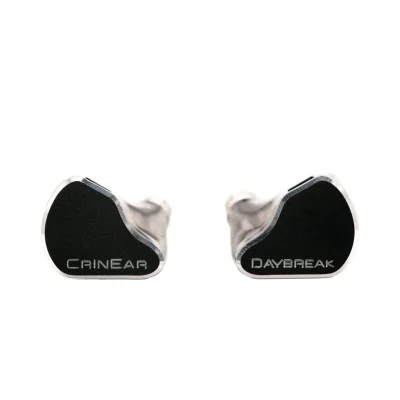Simgot EW300 and Crinear Daybreak use 1DD+1Planar+1PZT and 1DD+2BA+2mPT driver setups respectively. Simgot EW300 costs $69 while Crinear Daybreak costs $170. Crinear Daybreak is $101 more expensive. Crinear Daybreak holds a clear 0.9-point edge in reviewer scores (6.5 vs 7.3). Crinear Daybreak carries a user score of 7.4.
Insights
| Metric | Simgot EW300 | Crinear Daybreak |
|---|---|---|
| Bass | 6.5 | 7.6 |
| Mids | 6.5 | 7.4 |
| Treble | 6.5 | 6.6 |
| Details | 6.5 | 7.7 |
| Soundstage | 6.5 | 7 |
| Imaging | 6.5 | 7.7 |
| Dynamics | 6.5 | 7.4 |
| Tonality | 7.4 | 7.5 |
| Technicalities | 6.9 | 6.9 |
Simgot EW300 Aggregated Review Score
Average Reviewer Scores
Average Reviewer Score:
6.5Mixed to Positive
Crinear Daybreak Aggregated Review Score
Average Reviewer Scores
Average Reviewer Score:
7.3Generally Favorable
Reviews Comparison
Simgot EW300 reviewed by Jays Audio
Youtube Video Summary
The Simgot EW300 positions itself as a standout under $80, acting as a direct upgrade to the EW200 with more refined tuning and an uptick in layering/resolution. With the red 3.5 mm nozzle, the presentation is a dynamic, all-rounder tilt: upper-mids/treble are smoother and less peaky yet remain well-extended, vocals “pop” naturally, and separation feels tidier. In comparisons, the EA500 LM carries higher raw detail and a brighter, more exciting edge, but EW300’s calmer balance makes for longer, less fatiguing sessions and genuinely trades blows on preference.
Swapping to the pink nozzle shifts the EW300 into a warmer, bassier, and more laid-back profile with added thickness down low and a tamed 1–3 kHz region that helps vocal comfort and cuts fatigue. It suits rock, hip-hop, and metal while maintaining clean midrange boundaries, improved instrument separation, and a generally relaxing tone. Against similarly priced planars, the analog EW300 sounds less “sizzly” in timbre while holding its own on separation; owners of the original EA500 shouldn’t expect a huge jump here—the bigger step up remains the LM for sheer resolution.
The DSP version skews more vocal-focused and “clean balanced,” sacrificing some analog punch for smoothness and control. A deliberate 5–10 kHz softening plus a 13 kHz accent keeps consonants gentler and overall non-fatiguing, though some may find end-notes a touch too polite; the pink DSP profile further tames vocals while still giving satisfying cymbal crash. Practicalities are strong: the integrated DAC path shows a low noise floor with no odd artifacts on volume changes, and latency is a non-issue; for gaming, the analog 3.5 mm still images slightly better. Net: pick analog for slam and energy, or DSP for a smooth, vocal-centric clarity—either way, the EW300 offers real flexibility and polish at its price.
Jays Audio Youtube Channel
Buy Simgot EW300 on Linsoul
Ad
Price: $79.99
Buy Simgot EW300 on Linsoul
Crinear Daybreak reviewed by Jays Audio
Youtube Video Summary
The CrinEar Daybreak offers a balanced, clean, and non-fatiguing sound signature, functioning effectively as an all-rounder. Every frequency region is solid, delivering a smooth presentation without harshness or overwhelming warmth. The bass provides a slight sub-bass rumble and integrates cleanly into the mids, avoiding bleed, though it lacks significant impact, slam, or deep texture. Similarly, the mid-range and vocals are well-separated and forward enough, free from congestion or odd timbre, but don't specialize. The treble has enough extension and air, avoiding darkness or excessive sharpness, but misses out on micro-detail, sparkle, and expansive staging. It’s a decent, inoffensive performer across the board, described aptly as a "very good vanilla ice cream cone".
Technically, the Daybreak is competitive but not class-leading. Sets like the Meta, Ziigaat Crescent, Kiwi Ears Astral, Simgot EM6L, or TruthEar Nova offer slightly better detail retrieval, imaging, and resolution. Its main challenge comes from remarkably similar competitors, particularly the EPZ P50 and SLIIVO SL224, which share nearly identical tuning, driver configurations, and technical performance around the same $160-$180 price point. The P50 leans slightly more vocal-centric, while the SL224 offers marginally better bass texture and treble detail (though costing more). If you already own either, the Daybreak becomes largely redundant. Against alternatives like the bassier, more dynamic Ziigaat Odyssey ($200), the Daybreak feels safer but less engaging at higher volumes. Compared to Harman-tuned sets like the Supermix 4, Chopin, or Nova, the Daybreak boasts fuller tonality and less fatigue but gives up some layering and detail.
Ultimately, the Daybreak is a competent, well-packaged all-rounder at $170, delivering a balanced and inoffensive listen suitable for any genre library. However, it fails to stand out uniquely in a crowded field. Its sound signature is replicated almost exactly by the existing P50 and SL224. While it earns a half recommendation as a solid option for those seeking a non-fatiguing all-rounder who *don't* own those twins, it's unlikely to become a favorite due to its lack of distinctive character. Value is decent, but alternatives offer more specialization or technical prowess for similar or lower cost.
Jays Audio Youtube Channel
Buy Crinear Daybreak on Linsoul
Ad
Price: $169.99
Buy Crinear Daybreak on Linsoul
Simgot EW300 reviewed by Web Search
The Simgot EW300 offers a compelling tribrid driver configuration combining a 10mm dynamic driver, 6mm planar magnetic driver, and piezoelectric ceramic driver in a durable all-metal shell. Fit can be divisive due to the shorter nozzles, requiring tip experimentation for optimal seal, but the included detachable tuning nozzles (silver and gold) enable noticeable sound adjustments. The default silver nozzle delivers a balanced profile with punchy, well-controlled bass, a natural midrange favoring vocals, and treble that avoids excessive harshness despite occasional timbral quirks from the planar driver.
Swapping to the gold nozzle boosts bass warmth and smooths treble, aligning closer to a Harman-inspired tuning, which enhances positional audio clarity for gaming. Technical performance is solid for the price, with good detail retrieval and soundstage width, though complex tracks can expose minor congestion in layering. The occasional timbral unevenness in upper frequencies and sparse accessories are trade-offs, but the EW300’s cohesive tuning versatility across genres and activities makes it an exceptional value in its class.
Crinear Daybreak reviewed by Web Search
The CrinEar Daybreak is a tri-brid IEM built around a 5-driver array—1DD + 2BA + 2 micro-planar tweeters—with a moderate 20 Ω load and 105 dB/mW sensitivity, making it easy to drive from portable sources. MSRP sits at $169.99, placing it squarely in the competitive mid-budget segment. These core specs are confirmed on the official product page and retail listings.
Tonally, Daybreak trends toward neutral with a mild sub-bass lift and restrained warmth, but listener experience can swing with tip choice. Multiple independent impressions note a touch of upper-mid / lower-treble energy (ear-gain region) on stock narrow-bore tips, which relaxes with wide-bore options; overall midrange balance and resolution are strong for the price. These observations are echoed in in-depth evaluations and measurements from Headphones.com’s reviews.
Build is a resin shell with metal faceplate and a compact pseudo-custom profile; comfort is generally good, though the 6 mm nozzle and angle may not be ideal for every ear. Accessory quality is serviceable—SPC cable with interchangeable 3.5 mm / 4.4 mm terminations, a leatherette case, and basic tips—leaving room for aftermarket tip rolling to fine-tune treble behavior and staging. These physical details and inclusions are documented by the maker and retailers.
Simgot EW300 (more reviews)
Simgot EW300 reviewed by Kois Archive
Kois Archive Youtube Channel
Simgot EW300 reviewed by Gizaudio Axel
Simgot EW300 reviewed by
 Fresh Reviews
Fresh Reviews
Youtube Video Summary
Simgot EW300 makes a strong case as a sub-$80 tribrid benchmark, bringing a more natural timbre, better layering, and a small bump in resolution over EW200. With the red 3.5 mm nozzles, tuning is a lively all-rounder: punchy low end, smoother upper-mids/treble with fewer peaks, and vocals that pop without glare—essentially a more refined, less shouty evolution of EW200. Swap to the pink nozzles and the signature shifts warmer and bassier, taming 1–3 kHz for thicker body and reduced fatigue—great for rock, hip-hop, and metal—while keeping separation clean and the midrange free of bleed.
The DSP version pivots toward a clean, vocal-focused balance: extended yet smooth, effortless vocals, and low fatigue. A deliberate 5–10 kHz dip plus an airy upper push trades some bite for longer listening comfort; the pink DSP nozzle dials vocals even calmer while keeping cymbal crashes satisfying. Implementation quality stands out: a dedicated DAC section yields a low noise floor with no volume-change artifacts, and latency stays in check. For gaming and microdetail, the analog 3.5 mm edges ahead with slightly better imaging and resolution.
Against peers, EW300 trades blows with the EA500 LM—LM chases raw resolution with a brighter, more exciting tilt, whereas EW300 sounds smoother and easier for long sessions (OG EA500 owners won’t see a big upgrade, though layering/separation are a touch better). Versus other sub-$100 sets and entry-level planars, EW300’s timbre is less sizzly yet remains technically competent, and the two-nozzle system effectively gives two tunings in one. Taken together—analog punch, DSP polish, and genuine tuning flexibility—EW300 positions itself as a new value benchmark in its price class.
Fresh Reviews original ranking
Fresh Reviews Youtube ChannelSimgot EW300 reviewed by Head-Fi.org
Crinear Daybreak (more reviews)
Crinear Daybreak reviewed by Super* Review
Youtube Video Summary
The CrinEar Daybreak lands at $170 as the second IEM from Crinacle, positioned as a more accessible follow-up to the limited-edition Meta. This tribrid features a single dynamic driver, two balanced armatures, and two micro planars handling the highs. The build includes compact, semi-custom dark smoky resin shells offering good stability and comfort, though the molding might be slightly aggressive for some. The included cable provides swappable terminations (3.5mm and 4.4mm) but is noted for being somewhat stiff and kink-prone. Accessories are solid for the price, including a leatherette case and multiple tip options, with the stock silicones recommended for optimal fit due to the slightly longer nozzle.
Sonically, the Daybreak delivers what the review calls the best tonal balance yet within the popular "new meta" tuning category. Its frequency response is described as exceptionally neutral and natural from the mid-bass upwards, creating a low-contrast, chill, and non-fatiguing listen with forward, textured vocals and non-existent sibilance. However, this comes with trade-offs: the bass lacks ultimate tightness and slam, and the treble exhibits a light, wispy quality (likened to cotton candy) that lacks some bite and definition. While technical performance like imaging is solid, it doesn't stand out as exceptional.
In direct comparisons with six competitors around $200 (including the Meta, Binary x Chopin, EPZ P50, Ziigaat Lush, Truthear Pure, and Kiwi Ears KE4), the Daybreak consistently ranked highest for tonality. It was praised as a modern benchmark for natural tuning at its price. However, it fell behind in bass physicality and treble incisiveness. Ultimately rated a strong four stars, the Daybreak is highlighted as an excellent choice for those prioritizing a refined, natural midrange and easy listening experience over sheer technical prowess or visceral impact, earning the label of a "modern-day Etymotic ER2XR" with far better comfort.
Super* Review original ranking
Super* Review Youtube ChannelCrinear Daybreak reviewed by Audionotions
Crinear Daybreak reviewed by Paul Wasabii
Youtube Video Summary
CrinEar DayBreak presents a balanced end-to-end tuning that shifts with power. At low volume it can read warm and soft, but when driven a bit harder the bass and treble rise to meet the mids, revealing clean impact, clear treble extension from the BA + microplaner stack, and a more open presentation. Vocals carry natural body from a lower-mid bump without being pushed unnaturally forward, so the overall character leans more versatile than strictly vocal-centric.
Versus Meta, DayBreak fixes the bass shelf and stretches upper energy for easier air, trading some midrange push for better layering and imaging. Compared with Odyssey, high-volume listening yields more space and separation; against vocal sets like Cadenza 4 or Zero Red, DayBreak gives up a bit of mid focus but wins on genre range, especially EDM. Not a sub-bass monster, yet the bass hits harder than the graph suggests, with cleaner texture and a healthier sub-to-mid-bass ratio. The only nit is a slightly energetic 2–5 kHz zone that some will prefer a dB lower.
Call it an unintentional banger: the treble is sloped enough to avoid glare while keeping drops vivid, letting big builds explode without turning sharp. For listeners who play a notch louder and want balanced energy at both ends with mids that stay natural, DayBreak delivers a satisfying hybrid package for the price.
Paul Wasabii Youtube Channel
Crinear Daybreak reviewed by Jaytiss
Youtube Video Summary
The CrinEar Daybreak features a metal nozzle and metal faceplate with comfortable contours, though the fit is noted as a bit dainty and small. Isolation is practically non-existent, and the fit isn't particularly secure. The included cable looks nice and photographs well, featuring interchangeable terminations for versatility, but its chin slider moves too easily and isn't recommended for those needing a functional one. The case is deemed aesthetically pleasing and feels good, though not especially premium, magnetically shutting with adequate space.
Sonically, the Daybreak leans boring and somewhat sterile or dry. It offers nice bass and a lot of upper mids, which are done decently with a standard 3K peak. However, the combination of this upper-mid focus and an incisive peak around 8K contributes to a perceived harshness and sharpness, lacking in overall detail retrieval. Graph comparisons reveal its signature has significantly more upper mids and often more bass than competitors like the Moondrop Dusk or TruthEar Nova, resulting in a less engaging listen. Sets like the Defiant, Chopin, and Performer 7 are cited as more engaging alternatives at similar or lower prices, with the Defiant specifically recommended over the Daybreak. Even the Punch Audio martillo and Moondrop Meteor, sharing driver configurations, are considered more fun or better tuned.
Ultimately, the Daybreak is a solid A-minus IEM, well-packaged and a commendable first effort for the brand, but it's not hypeworthy or a benchmark. It lacks imagination and falls short against numerous compelling alternatives around its price point, such as the Performer 7, ZOS Defiant, Chopin, or discounted planar options like the Aether. While a good value, especially if found on sale via Linsoul or the used market, its piercing upper mids and failure to truly excel make it hard to fully recommend over the competition.
Jaytiss Youtube Channel
Crinear Daybreak reviewed by Fox Told Me So
This is it.
Crinear Daybreak's tuning follows the New Meta family with two quirks: a dip at 400 Hz that slightly thins male vocals, and a dip around 8 kHz that smooths treble but softens cymbals/overtones. Otherwise it’s safe, balanced, and within preference bounds.
Bass has moderate body with audible rumble and quick decay, though slam could hit harder; Mids sit neutral, neither pushed nor recessed, keeping instruments evenly balanced; Treble rolls off smoothly—pleasant, but lacks the final lift that would open it up. Resolution is average for the price: clear layers but compressed depth, like a lasagna being pressed flat.
Within the $169 bracket, Daybreak is neutral, natural, and non-fatiguing—an easy daily driver.
Fox Told Me So original ranking
Fox Told Me So Youtube ChannelCrinear Daybreak reviewed by Z-Reviews
Youtube Video Summary
The Crinacle Daybreak is a technically excellent IEM that offers exceptional clarity and detail retrieval without being fatiguing. Its five-driver configuration delivers a cohesive and precise sound signature that is clean, flat, and incredibly balanced. The bass is present and punchy but never exaggerated, making it a perfect tool for studying music and hearing every nuance in a recording.
However, this precision comes at the cost of fun. The tuning is described as a little dry and somewhat intimate, lacking the expansive soundstage and flavorful character that makes other IEMs more engaging for pure enjoyment. While the build is solid with an acceptable cable and nice connectors, its looks are admittedly boring. It’s a perfectly cooked meal that follows the recipe without any surprises.
Ultimately, the Daybreak is a highly respected and much-loved IEM that fills a specific niche for a clean, reference-like sound. It’s a business suit of an IEM, but it wouldn't be the first choice for someone looking for a more exciting, fun, or "f***ed up" sound signature to get them moving. It commands respect for its technical merits, even if it isn't to everyone's personal taste.
Z-Reviews Youtube Channel
Simgot EW300 Details
Driver Configuration: 1DD+1Planar+1PZT
Tuning Type: V-Shaped
Brand: Simgot Top Simgot IEMs
Price (Msrp): $69
Support our free service! Buying through our affiliate links costs you nothing extra:
Crinear Daybreak Details
Driver Configuration: 1DD+2BA+2mPT
Tuning Type: Neutral with Bass Boost
Brand: CrinEar Top CrinEar IEMs
Price (Msrp): $169.99
Support our free service! Buying through our affiliate links costs you nothing extra:
Simgot EW300 User Review Score
Average User Scores
Average User Score: n/a
Based on 0 user reviews
No user reviews yet. Be the first one who writes a review!
Crinear Daybreak User Review Score
Average User Scores
Average User Score:
Based on 1 user reviews
7.4Generally Favorable
Simgot EW300 Gaming Score

Gaming Score & Grade
- The gaming score is prioritizing technical capabilities of the IEM (Separation, Layering, Soundstage) and good value.
Gaming Score
6.6Gaming Grade
B+Crinear Daybreak Gaming Score

Gaming Score & Grade
- The gaming score is prioritizing technical capabilities of the IEM (Separation, Layering, Soundstage) and good value.
Gaming Score
7.1Gaming Grade
A-Simgot EW300 Scorings
Average Technical & Tuning Grades
Average Tunign Grade
A-- A smooth, agreeable balance keeps the presentation engaging without obvious flaws. Only sensitive ears will nitpick the bumps.
Average Technical Grade
B+- It offers a competent showing, maintaining cohesion on straightforward arrangements. Complex passages start to challenge it, but never derail the show.
Crinear Daybreak Scorings
Average Technical & Tuning Grades
Average Tunign Grade
A- Tuning lands in a pleasing sweet spot with mostly coherent frequency integration. Tonality stays consistent from track to track.
Average Technical Grade
B+- The presentation is steady if unspectacular, holding onto essential details when the music stays simple. Fine details occasionally slip through the cracks.
Simgot EW300 User Reviews
"This is an example review"
Pros
- Example pro 1
- Example pro 2
Cons
- Example con 1
- Example con 2
Share your experience and build your personal ranking list.
You need to be signed in to write your own reviewCrinear Daybreak User Reviews
Share your experience and build your personal ranking list.
You need to be signed in to write your own reviewA well-toned, easy-listening IEM that excels at midrange clarity even if it doesn’t dazzle technically.
Pros
Balanced and non-fatiguing tuning with smooth, natural mids.Cons
Bass lacks slam and treble can feel veiled or lacking crisp sparkle.Find your next IEM:
IEM Finder Quiz
newIEM Comparison Tool
newVS

























